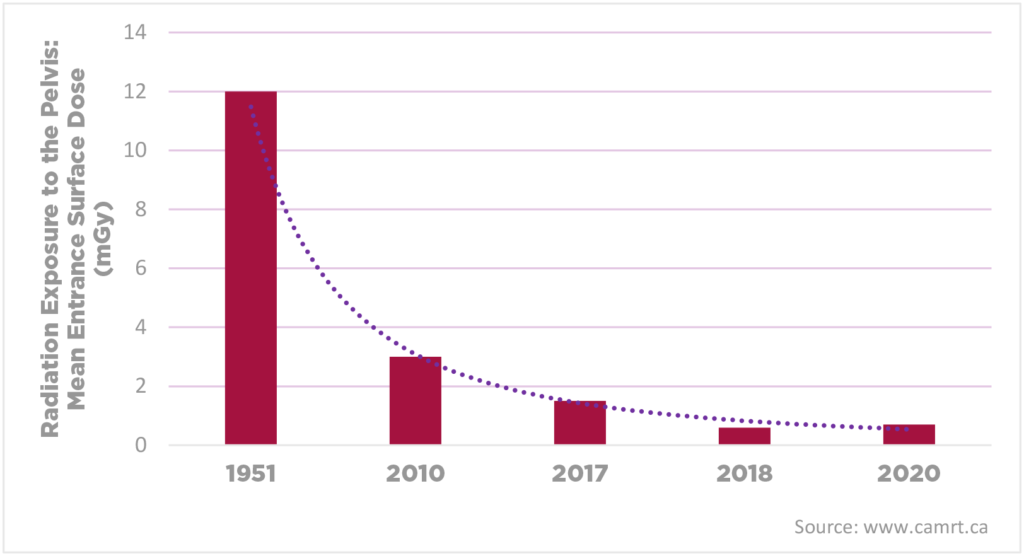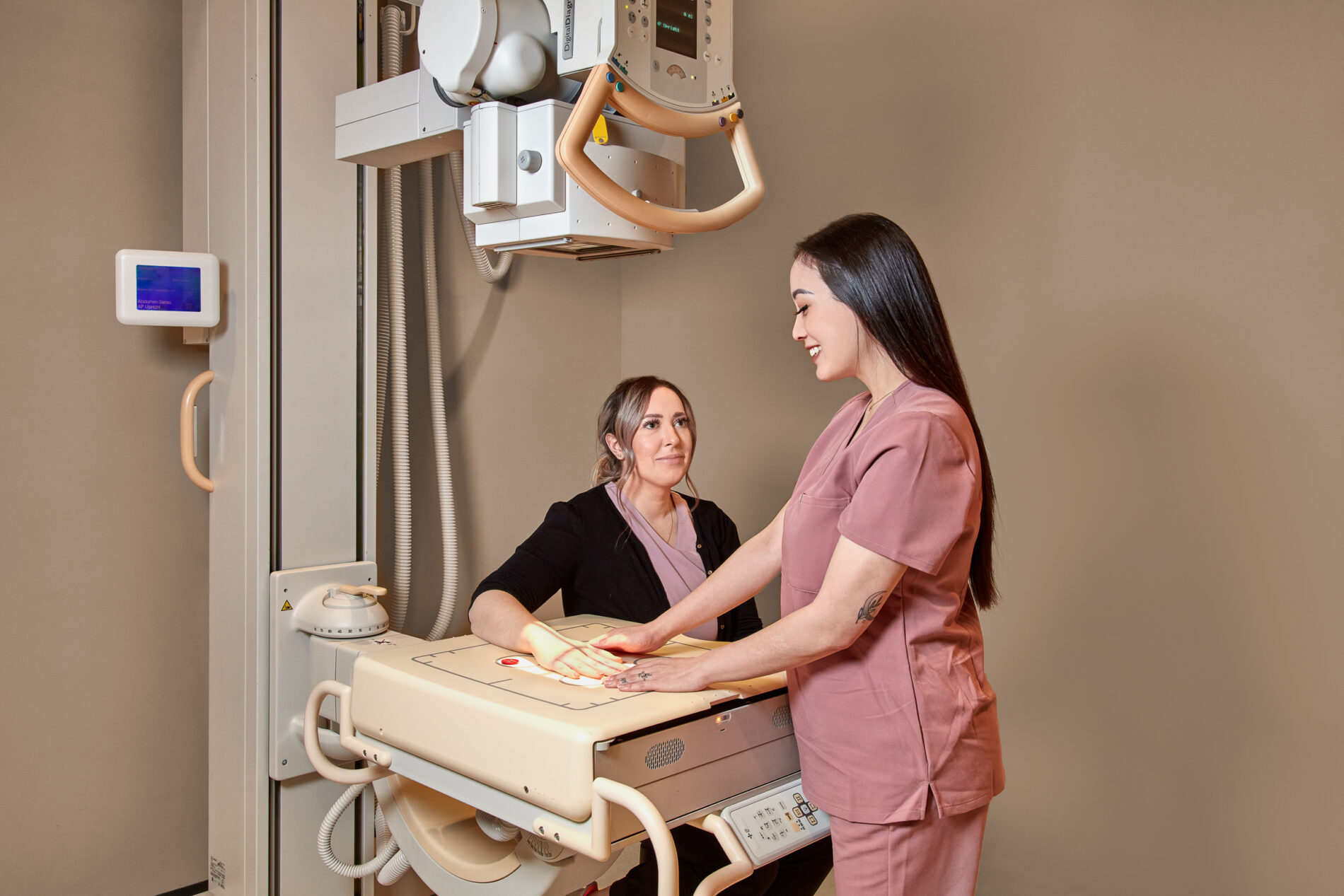MIC Medical Imaging will no longer use routine lead shielding in diagnostic imaging exams like x-ray. Historically, lead shielding has been seen as an important precaution in reducing radiation exposure to non-targeted areas of the body and an important component of the “As Low As Reasonably Achievable” (ALARA) principle.23
While this policy change may seem surprising, various organizations both locally and internationally have made adjustments to align with new imaging recommendations.
So, what changed since the last time you had an x-ray?
There are three main reasons why we no longer recommend gonadal and fetal shielding during routine diagnostic imaging exams like x-ray.
Decades of Research
Today’s data shows negligible benefit for the patient or fetus. In 70 years of research, no studies have proven the harmful effects of x-rays on reproductive organs or the fetus (unborn baby) during diagnostic imaging. However, studies have shown that the human body is not as sensitive to radiation as we used to believe. 5,14,15,20,21
Technological Advancements
Medical imaging technology has improved dramatically over the decades. On average, patients receive 20-25 times less radiation than they did in the 1950s.5,12,15

Our Bodies Are Unique
Different compositions and physiology can cause shielding to be easily misplaced. Poorly placed shielding can drastically impact the quality of the x-ray. 8,9,16,17,19 Furthermore, there is a risk that the lead shielding will obscure anatomy that is important for an accurate diagnosis and cause the procedure to be repeated. 11
The Healthcare Community
The following organizations have implemented the same changes or publicly support the movement away from lead shielding in routine diagnostic imaging exams like x-ray:
- Alberta Health Services (AHS)
- Canadian Association of Radiologists (CAR)
- American College of Radiology (ACR)
- Canadian Association of Medical Radiation Technologists (CAMRT)
- Canadian Association of Medical Physicists (COMP)
- American Association of Physicists in Medicine (AAPM)
MIC’s Position
MIC is a trusted partner to Edmonton’s primary care practitioners, specialists, and surrounding communities. We are dedicated to making a difference in the lives of our patients, which means we must constantly evaluate policies, procedures, industry standards, and best practices.
Since shielding can introduce unnecessary risks and provides no benefit to a patient’s health, our leadership, radiologists, and Radiography Coordinator believe there is sufficient evidence to change our shielding policy.
Lead Shielding FAQ
American College of Radiology (ACR). ACR-AAPM-SIIM-SPR Practice parameter for digital radiography. Resolution 40. Published 2018. Accessed May 13, 2020. https://www.acr.org/-/media/ACR/Files/Practice-Parameters/Rad-Digital.pdf
American College of Radiology (ACR). ACR-SPR. Practice parameter for imaging pregnant or potentially pregnant adolescents and women with ionizing radiation. Resolution 39. Published 2018. Accessed May 13, 2020. https://www.acr.org/-/media/ACR/Files/Practice-Parameters/Pregnant-Pts.pdf
Bjarnason TA, Rees R, Kainz J, et al. COMP report: A survey of radiation safety regulations for medical imaging x-ray equipment in Canada. J Appl Clin Med Phys. 2020;21(3):10-19. doi:10.1002/acm2.12708
Billings MS, Norman A, Greenfield MA. Gonad dose during routine roentgenography. Radiology. 1957;69(1):37-41. doi:10.1148/69.1.37
Brent, R. L., Frush, D. P., Harms, et al. (2013). Preconception and Prenatal Radiation Exposure: Health Effects and Protective Guidance Recommendations of the National Council on Radiation Protection and Measurements.
Dauer LT, Thornton RH, Hay JL, Balter R, Williamson MJ, St. Germain J. Fears, feelings, and facts: Interactively communicating benefits and risks of medical radiation with patients. AJR Am J Roentgenol. 2011;196(4). doi:10.2214/AJR.10.5956
Fawcett SL, Barter SJ. The use of gonad shielding in paediatric hip and pelvis radiographs. Br J Radiol. 2009;82(977):363-370. doi:10.1259/bjr/86609718
Fawcett SL, Gomez AC, Barter SJ, Ditchfield M, Set P. More harm than good? The anatomy of misguided shielding of the ovaries. Br J Radiol. 2012;85(1016):e442-447. doi:10.1259/bjr/25742247
Frantzen MJ, Robben S, Postma AA, Zoetelief J, Wildberger JE, Kemerink GJ. Gonad shielding in paediatric pelvic radiography: Disadvantages prevail over benefit. Insights Imaging. 2011;3(1):23-32. doi:10.1007/s13244-011-0130-3
Frantzen, M. J., Robben, S., Postma, A. A., Zoetelief, J., Wildberger, J. E., & Kemerink, G. J. (2012). Gonad shielding in paediatric pelvic radiography: disadvantages prevail over benefit. Insights Imaging, 3, 23–32.
Handloser JS, Love RA. Radiation doses from diagnostic x-ray studies. Radiology. 1951;57(2):252-254. doi:10.1148/57.2.252
International Atomic Energy Agency. Radiation protection and safety in medical uses of ionizing radiation, specific safety guide no. SSG-46. Accessed May 13, 2020. https://www-pub.iaea.org/MTCD/Publications/PDF/PUB1775_web.pdf
International Commission on Radiological Protection. The 2007 Recommendations of the International Commission on Radiological Protection. ICRP publication 103. Ann ICRP. 2007;37(2-4):1-332. doi:10.1016/j.icrp.2007.10.003
Jeukens CRLPN, Kütterer G, Kicken PJ, et al. Gonad shielding in pelvic radiography: Modern optimised x-ray systems might allow its discontinuation. Insights Imaging. 2020;11. doi:10.1186/s13244-019-0828-1
Karami V, Zabihzadeh M, Shams N, Saki Malehi A. Gonad shielding during pelvic radiography: A systematic review and meta-analysis. Arch Iran Med. 2017;20(2):113-123. doi:0172002/AIM.0011
Kenny N, Hill J. Gonad protection in young orthopaedic patients. BMJ. 1992;304(6839):1411-1413.
Lee, M. C., Lloyd, J., & Solomito, M. J. (2017). Poor Utility of Gonadal Shielding for Pediatric Pelvic Radiographs. Orthopedics, 40(4), e623–e627.
Liakos P, Schoenecker PL, Lyons D, Gordon JE. Evaluation of the efficacy of pelvic shielding in preadolescent girls. J Pediatr Orthop. 2001;21(4):433-435.
Marsh RM, Silosky M. Patient shielding in diagnostic imaging: Discontinuing a legacy practice. Am J Roentgenol. 2019;212(4):755-757. doi:10.2214/AJR.18.20508
National Research Council. Health risks from exposure to low levels of ionizing radiation: BEIR VII phase 2. Published 2006. Accessed May 13, 2020. https://scholar.google.com/scholar_lookup?hl=en&publication_year=2006&author=National+Research+Council&title=Health+risks+from+exposure+to+low+levels+of+ionizing+radiation%3A+BEIR+VII+phase+2.
Oikarinen HT, Perttu AM, Mahajan HM, et al. Parents' received and expected information about their child's radiation exposure during radiographic examinations. Pediatr Radiol. 2019;49(2):155-161. doi:10.1007/s00247-018-4300-z
Strauss KJ, Kaste SC. The ALARA (as low as reasonably achievable) concept in pediatric interventional and fluoroscopic imaging: Striving to keep radiation doses as low as possible during fluoroscopy of pediatric patients. Pediatr Radiol. 2006;36(Suppl 2):110-112. doi:10.1007/s00247-006-0184-4
Wainwright AM. Shielding reproductive organs of orthopaedic patients during pelvic radiography. Ann R Coll Surg Engl. 2000;82(5):318-321.
Warlow T, Walker-Birch P, Cosson P. Gonad shielding in paediatric pelvic radiography: Effectiveness and practice. Radiography. 2014;20(3):178-182. doi:10.1016/j.radi.2014.01.002
